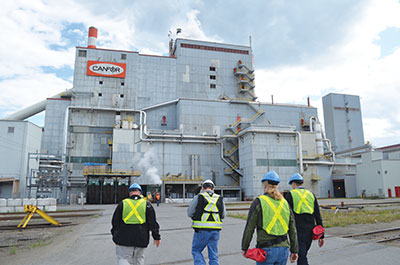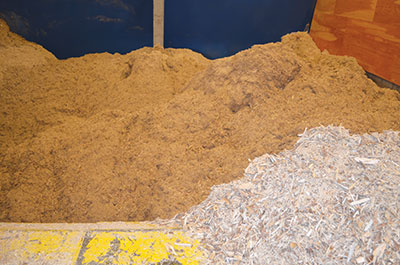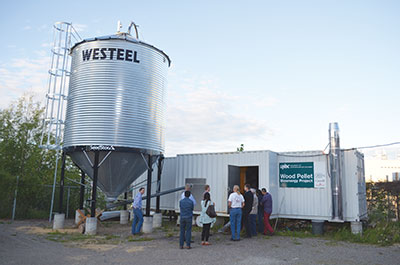
Biomass boom
August 5, 2014
By
Andrew Macklin
Ten years after a report identified a surplus of wood waste going to landfills for incineration, B.C. has become the heartland of the wood bioenergy industry in Canada. Sawmill and forest residues have become a staple for the expanding wood pellet industry and the growth of co-generation facilities across the province.
Ten years after a report identified a surplus of wood waste going to landfills for incineration, B.C. has become the heartland of the wood bioenergy industry in Canada. Sawmill and forest residues have become a staple for the expanding wood pellet industry and the growth of co-generation facilities across the province. At the centre of that growth is Prince George, the “northern capital” of the province.
 |
|
| The Canfor cogeneration plant, located at the company’s Prince George Pulp and Paper mill, consumes 225,000 tonnes of woody biomass (hog fuel) each year.
|
Natural Resources Canada released a report in November of 2005, in conjunction with the Forest Products Association of Canada (FPAC), highlighted the opportunities for the biomass industry in British Columbia. The report, entitled Estimated Production, Consumption and Surplus Mill Wood Residues in Canada-2004, analyzed the surplus of wood residues across Canada, how they were being disposed of, and the potential for future uses. It was estimated that a surplus of 1,814,955BDT of wood residues were being disposed of either in managed wood residue landfills or by incineration in B.C. alone.
The report went on to say that “Possible future energy projects to utilize the surplus wood residue include the conversion of sawmills from natural gas to hog fuel energy systems, wood pellet, board and panel manufacturing and stand-alone power generation. These projects could decrease the surplus available to virtually zero in some parts of the B.C. interior.”
The industry responded to this report and Prince George, a community of nearly 90,000, has become a focal point for B.C.’s biomass industry thanks to the commitments made by the community’s forestry, biomass, government and education leaders.
Pacific Bioenergy
Established in 2004 in Vancouver, Pacific Bioenergy has been a driving force for the Prince George bioeconomy. The company’s flagship pellet plant, located just south of the city, was established in 2007.
Just a few years later, in February of 2010, Pacific Bioenergy announced a $24 million expansion. The expansion would help the company meet the demands of a new supply contract: 10 years at 250,000 tonnes per year to GDF Suez. The expansion, and the new contract, helped Pacific Bioenergy grow its annual production capacity to 400,000 tonnes, the second largest pellet plant capacity in Canada.
Pacific Bioenergy has worked diligently to secure a long-term fibre supply, one of the biggest issues facing the wood pellet industry in B.C. The company currently holds a forest license in the Quesnel timber supply area (TSA) for 700,000m3 for 15 years. The contract covers an area of over one million hectares in the heart of mountain pine beetle infected wood from the City of Quesnel to the boundary of Tweedsmuir Park. Coupled with medium- to long-term contracts already in place with regional logging contractors and sawmills, Pacific Bioenergy has as stable a biomass supply as can be found in B.C.
Establishing biomass cogeneration
The sawmill industry, as well as pulp and paper industry, have long since been staples of Prince George’s industrial community. Canadian Forest Products (Canfor), TimberWest and Sinclar Group Forest Products (Lakeland Mills) are all established both in Prince George and throughout the region.
 |
|
| The locally supplied hog fuel for UNBC’s Nexterra system helps to reduce both logistics costs and GHG emissions.
|
In November of 2003, Canfor announced that they would be building an $81-million cogeneration facility at its Prince George pulp mill. The facility, in cooperation with B.C. Hydro, would create enough power for 39,000 homes and significantly reduce the company’s dependence on electricity and natural gas resources.
The construction of the cogeneration plant provided benefits on several levels for Canfor, B.C. Hydro and the community.
For Canfor, the move also helped to retire two of Canfor’s beehive burners, in Bear Lake and Isle Pierre, as the new cogeneration facility would require an annual volume of 225,000 tonnes of hog fuel. The greenhouse gas emission reduction from eliminating the beehive burners vs. using the hog fuel in the cogen facility was the equivalent annual volume of natural gas used in approximately 5,500 homes.
For B.C. Hydro, it meant that much of the power demand needed for Canfor’s two mills (at the time) would be covered by the new electricity generation. Canfor was producing 390GWh with the new plant, while it used 415GWh of electricity. The 390GWh now freed up for use by B.C. Hydro was equal to the company’s projected increase in hydro use for the 15 years to follow.
For the community, it meant stabilized hydro rates thanks to savings in the purchase price of power for B.C. Hydro. It also meant lower emissions in the region.
The Canfor project also opened the door for the expansion of biomass for heat and power generation in the community, as evidenced by the developments since 2007 on the campus of the University of Northern British Columbia (UNBC).
In 2007, the university completed its green energy plan, looking for ways to reduce the campus’ carbon footprint and adopt green solutions for its expanding energy needs.
In 2009, UNBC became the first university in Canada to own and operate its own biomass system. A pellet boiler, with a peak capacity of 400kW, was installed to heat the Enhanced Forestry Lab greenhouse. The pellets for the boiler were donated to the campus in an agreement with Pacific Bioenergy.
In 2011, the university introduced Phase II of the campus’ bioenergy system, the installation of a Nexterra biomass gasification system. The $16.7-million bioenergy plant project was introduced to help reduce the cost of natural gas heat used to power the core of the campus. The biomass supply is provided as part of a five-year supply agreement with Lakeland Mills sawmill in Prince George. The mill sells biomass to UNBC by the bone dry tonne. To date, the use of the biomass has reduced the campus’ annual purchase of natural gas by approximately $700,000 per annum.
Community district heating
The university isn’t the only group in Prince George to adopt the use of biomass for heat and power for its core buildings.
 |
|
| The 400kW pellet boiler installed at UNBC is the first to be owned and operated by a Canadian university.
|
The community’s municipal council has also adopted the use of biomass for heat and power. Approved by City Council in June of 2010, the Prince George District Energy System (DES) was introduced to provide carbon neutral green energy and improve the air quality in the community.
Construction of the Peaking Backup Energy Centre began in July of 2011 and was completed in March of 2012. The system provides power and hot water in coordination with the Lakeland Mills sawmill, which provides the power to the system through its energy system that uses woody biomass.
Since the system became active in the spring of 2012, eight buildings have become part of the DES in Prince George’s downtown core, including the RCMP headquarters, City Hall, Civic Centre, and the Wood Innovation and Design Centre (under construction). In 2013, use of the DES reduced the city’s natural gas consumption by 17,000 gigajoules, enough to supply heat for 110 homes annually.
A fitting host
The Prince George Civic Centre is also home to Canada’s largest bioenergy conference: the International Bioenergy Conference & Expo (IBCE). The biennial event has called Prince George home since its humble beginning in 2004, when it was held in conjunction with Forest Expo.
In June of 2014, at the 6th IBCE, over 300 attendees, 43 presenters and close to 50 exhibitors descended on the community to discuss important issues affecting Canada’s bioeconomy (see www.canadianbiomass.magazine.ca/content/view/4594/133/). Among those presenters were some of the community leaders who have helped push the community bioeconomy forward, including Brad Bennett of Pacific Bioenergy, Ken Shields of Canfor, Rob van Adrichem of UNBC and Prince George MLA Shirley Bond. The conference also included a pre-conference tour throughout the B.C. Interior with stops at the Canfor cogeneration plant and both of the UNBC biomass facilities.
This commitment from partners throughout the community’s biomass industry drives Prince George’s growth as one of Canada’s emerging bioeconomies.
Print this page